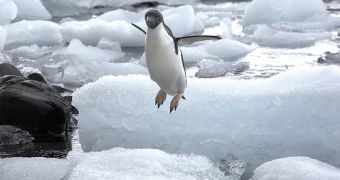Scientists at the GFZ German Research Center for Geosciences analyzed data from the German-American satellite mission GRACE (Gravity Recovery and Climate Experiment), and observed for the first time the differences in the ice mass of the Antarctic ice sheet caused by El Niño.
Thanks to the gravity field satellites, the researchers found that every year's mass variations in the western Antarctic, are mainly caused by differences in precipitation, attributable to this weather phenomenon.
What they did not know until now, was that there are significant discrepancies in the western coastal area of the South Pole, and this change in the ice covering Antarctica is a critical factor in global climate events.
There are actually two very important areas in Antarctica, especially for the global climate change – the Antarctic Peninsula and the Amundsen Sector of West Antarctica.
The Antarctic Peninsula is currently undergoing a warming exceeding the global average and the disappearance of large ice shelf areas, as for the Amundsen Sector of West Antarctica, it has the largest flow rates and mass loss of the Antarctic Ice Sheet.
In both regions there is a 0.3 millimeters per year of ice retreat or melting and this contributes to the rise of the global sea level of almost three millimeters a year.
GFZ scientists Ingo Sasgen said that “with the GRACE time series, it was for the first time possible to observe how the large-scale ice mass varies in the two areas due to fluctuations in rainfall from year to year.”
Scientists knew for a while that the Pacific El Niño climate phenomenon is linked to the snowfall in Antarctica, but now they actually saw how.
Also, besides the warm El Niño there is the cold La Niña, which also affects the Antarctic climate: "the cooler La Niña years lead to a strong low pressure area over the Amundsen Sea, which favors heavy rainfall along the Antarctic Peninsula - the ice mass is increasing there,” Professor Maik Thomas, head of the section "Earth System Modelling" at the German Research Center for Geosciences (Helmholtz Association), explains.
“In contrast, the Amundsen area is dominated by dry air from the interior during this time.
“El Niño years with their warm phase lead to precisely the opposite pattern: reduced rainfall and mass loss in the Antarctic Peninsula, and an increase in the Amundsen Sectorfield, respectively,” he adds.
The scientists will keep on analyzing data from the GRACE satellite and try to better understand the global climate change.

 14 DAY TRIAL //
14 DAY TRIAL //